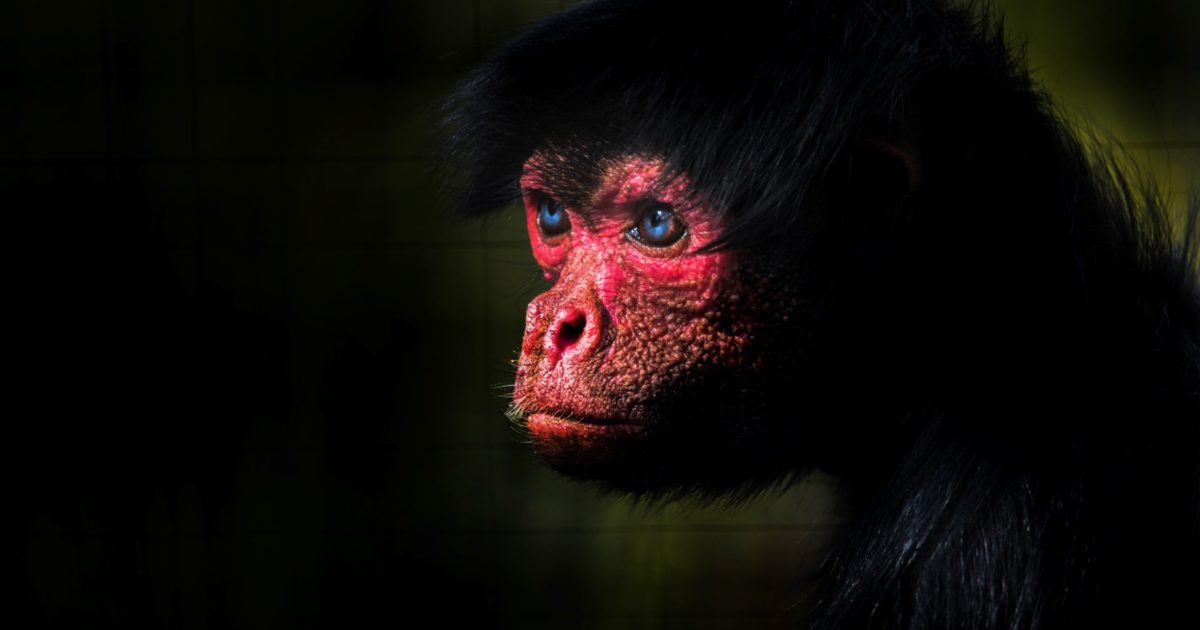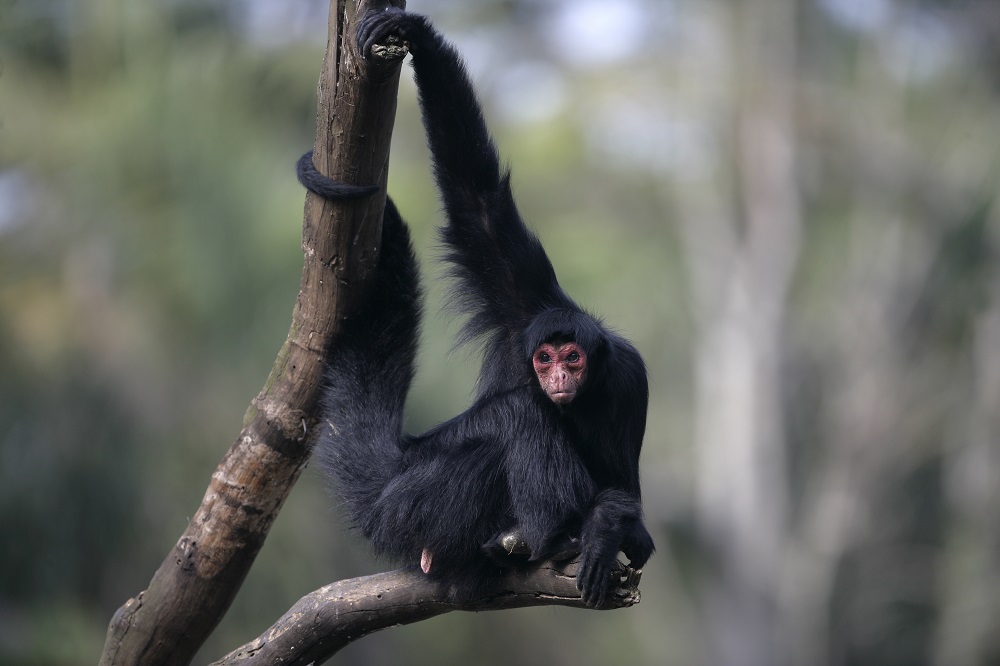A look at “15 Interesting Facts About Black Spider Monkey (Ateles paniscus)” The Black Spider Monkey, scientifically known as Ateles paniscus, is a fascinating primate species found in the tropical rainforests of Central and South America.
These intelligent creatures have captured the attention of researchers and nature enthusiasts alike. In this article, we will explore 15 interesting facts about the Black Spider Monkey, shedding light on their habitat, behavior, adaptations, and more.

15 Interesting Facts About Black Spider Monkey (Ateles paniscus)
Spider monkeys are New World monkeys found in the tropical and subtropical rainforests of Central and South America. Their name is the result of their spiderlike appearance when they hang by their extra long prehensile tails from the bow of a tree.
There are seven species and seven subspecies of spider monkeys, and all are at risk of extinction due to habitat loss and hunting. Spider monkeys are primarily herbivores and frugivores that are quite social and tend to live in large groups. From their lack of opposable thumbs to their ability to cover large distances with a single swing, discover the most fascinating facts about spider monkeys.
1. Habitat and Distribution
Black Spider Monkeys inhabit the dense rainforests of Central and South America. They are primarily found in countries such as Brazil, Colombia, Ecuador, Guyana, Peru, and Venezuela. These monkeys thrive in the upper canopy layers of the rainforest, where they spend most of their lives swinging from tree to tree.
2. Physical Characteristics
These monkeys are known for their lanky limbs and long, prehensile tails, which act as an extra limb for climbing and hanging. Black Spider Monkeys have a black or dark brown coat, giving them their name. They possess long, slender fingers and a reduced thumb, which helps them maintain a secure grip on branches.
3. Social Behavior
Black Spider Monkeys are highly social animals, typically living in large groups called troops. Troops can consist of up to 35 individuals, including both males and females. These monkeys engage in cooperative behaviors, such as grooming each other, to strengthen social bonds within the group.
4. Diet and Feeding Habits
The diet of Black Spider Monkeys primarily consists of fruits, seeds, leaves, and flowers. They have a unique feeding style called “frugivory,” which means they primarily consume fruits. Their specialized digestive system allows them to efficiently break down plant material and extract nutrients.
5. Reproduction and Family Structure
Female Black Spider Monkeys reach sexual maturity around the age of five, while males mature slightly later. Once a female gives birth, the infant clings to her belly for the first few months and gradually transitions to riding on her back. The entire group takes care of the young monkeys, displaying a cooperative parenting structure.
6. Vocalizations and Communication
Black Spider Monkeys communicate through a variety of vocalizations, including screams, barks, and hoots. These vocalizations serve as a means of maintaining contact within the group, warning of danger, and expressing dominance. Each monkey has a unique voice, allowing for individual recognition.
7. Arboreal Adaptations
Being well-adapted to an arboreal lifestyle, Black Spider Monkeys have several features that aid in their tree-dwelling existence. Their long limbs and strong grasping tail provide agility and balance while moving through the forest canopy. Additionally, their exceptional eyesight helps them navigate the complex jungle environment.
8. Endangered Status
Unfortunately, the Black Spider Monkey is listed as an endangered species by the International Union for Conservation of Nature (IUCN). Habitat loss due to deforestation and illegal hunting pose significant threats to their survival. As human activities continue to encroach upon their habitat, the population of Black Spider Monkeys has been declining rapidly.
9. Threats and Conservation Efforts
The primary threat to Black Spider Monkeys is deforestation. The rapid destruction of their natural habitat for logging, agriculture, and infrastructure development has left them with limited areas to roam and find food. Additionally, they are vulnerable to hunting for their meat and the illegal pet trade.
Conservation organizations and local communities are working tirelessly to protect the Black Spider Monkey. Efforts include the establishment of protected areas, reforestation initiatives, and raising awareness about the importance of their conservation. It is crucial to address the root causes of deforestation and promote sustainable practices to ensure the long-term survival of these magnificent creatures.
10. Relationship with Other Species
Within their ecosystem, Black Spider Monkeys play a vital role as seed dispersers. By consuming fruits and traveling long distances, they help in the dispersal of seeds, contributing to the regeneration of the forest. Their survival is interconnected with the health of the entire rainforest ecosystem, making them an essential species to conserve.
11. Cultural Significance
Black Spider Monkeys hold cultural significance for indigenous communities living in their range. These communities often incorporate the monkeys’ behaviors and characteristics into their folklore, music, and artwork. They symbolize resilience, adaptability, and the interconnectedness of all living beings.
12. Unique Adaptations
One remarkable adaptation of Black Spider Monkeys is their ability to move swiftly through the treetops. Their long limbs and flexible tail allow them to perform incredible acrobatic feats, effortlessly leaping from branch to branch. This agility helps them evade predators and efficiently forage for food.
13. Spider Monkey Myths and Misconceptions
There are several myths and misconceptions surrounding Spider Monkeys. One common misconception is that they are aggressive or dangerous. In reality, they are shy and generally avoid confrontation with humans. It is important to dispel these misconceptions and promote a better understanding of their behavior and needs.
14. The Females Take the Lead
Spider monkey troops are matriarchal, meaning the females play a leadership role. Females actively choose their mates when breeding, which, in the case of white-bellied spider monkeys, leads to less aggressive behavior among males. The alpha female of the troop also tends to be the decision-maker, leading the group to feeding areas and determining the ultimate size of the group.
Female spider monkeys are also more likely to leave the nest, moving on to join a new troop when they reach puberty.
READ RELATED: Lucy Aharish- Wiki, Age, Height, Net Worth, Husband, Ethnicity
15. They Are Swinging Specialists
Rather than leap from tree to tree, spider monkeys are specialists at swinging from limb to limb, and can clear great distances in a single swing. Spider monkeys can cover as much as 30 feet of distance with a single powerful swoosh of their arms. Their hook-like hands, powerful tail, and mobile shoulder joints assist spider monkeys with their impressive moves.
These agile acrobats can pause between swings to stand up or hang from their tail to eat with both hands.
Physical Characteristics
Black Spider Monkeys are distinguishable by their black or dark brown fur, which covers their body, excluding their face and ears. They have a lean and slender body structure, which allows for agility and easy movement through the forest canopy. These monkeys have long limbs and an average height of around 60 to 75 centimeters (24 to 30 inches).
Prehensile Tail
One of the most remarkable features of Black Spider Monkeys is their prehensile tail. This specialized tail acts as a fifth limb, allowing them to grasp and hold onto tree branches with great precision. Their tail is muscular and has a hairless underside that provides a better grip. This adaptation aids them in navigating the complex forest environment.
Limbs and Adaptations
Black Spider Monkeys possess long and powerful limbs, ideal for swinging and brachiating (moving through trees by using their arms). Their arms are longer than their legs, enabling them to swing with remarkable speed and agility from branch to branch. Additionally, their fingers are elongated and dexterous, providing excellent grip and precision while maneuvering through the forest canopy.
Diet and Feeding Habits
The diet of Black Spider Monkeys is predominantly frugivorous, meaning they primarily consume fruits. However, they are also known to incorporate other plant materials into their diet, including leaves, flowers, nuts, and seeds. Their specialized digestive system allows them to efficiently break down plant matter and extract nutrients from their food sources.
Seed Dispersal Role
Black Spider Monkeys play a crucial role in seed dispersal within the rainforest ecosystem. As they consume fruits, they inadvertently disperse seeds through their feces. This process helps in the regeneration of the forest by spreading seeds to new areas, contributing to the biodiversity and sustainability of the ecosystem.
Vocalizations and Communication
Communication among Black Spider Monkeys is vital for social cohesion and coordination within the troop. They use a range of vocalizations, including screams, barks, and hoots, to convey messages and maintain contact with other group members. Each monkey has a distinct voice, allowing for individual recognition
and communication within the troop.
Endangered Status
Unfortunately, Black Spider Monkeys are listed as an endangered species by the International Union for Conservation of Nature (IUCN). The destruction of their natural habitat, primarily due to deforestation, poses a significant threat to their survival. Additionally, they are targeted by illegal hunting for their meat and the pet trade, further contributing to their declining population.
Conservation Efforts
Conservation organizations and local communities are actively involved in efforts to protect the Black Spider Monkey. Initiatives include the establishment of protected areas, restoration of degraded habitats, and community-based conservation projects. By raising awareness about the importance of preserving their natural habitat and combating illegal hunting, these efforts aim to safeguard the future of these remarkable primates.
Interesting Facts

- Black Spider Monkeys are considered one of the largest New World monkeys, with males weighing up to 9 kilograms (20 pounds).
- They have an incredibly long lifespan, often reaching 30 to 35 years in the wild.
- Black Spider Monkeys have an exceptional sense of sight, allowing them to spot food sources and navigate the dense rainforest canopy.
- They are highly arboreal, spending most of their lives in the treetops and rarely descending to the forest floor.
- Black Spider Monkeys exhibit remarkable agility and are capable of leaping up to 9 meters (30 feet) between trees.
- Infants rely on their mother for nourishment and cling to her for the first few months of their lives.
- Black Spider Monkeys have a complex vocal repertoire, using different calls to communicate various messages within the troop.
- Their foraging behavior contributes to forest regeneration by dispersing seeds over wide areas.
- Despite their name, Black Spider Monkeys do not build or use spider-like webs or nests.
- These monkeys have a gentle and docile temperament, often avoiding conflicts with other animals and humans.
Conclusion
The Black Spider Monkey, with its captivating appearance and intriguing behaviors, holds a significant place in the biodiversity of the rainforests. However, their population is declining due to habitat loss and other threats. It is crucial for us to take action and prioritize their conservation to ensure their survival and the preservation of our planet’s rich natural heritage.
FAQs (Frequently Asked Questions)
Q: Are Black Spider Monkeys carnivorous? A: No, Black Spider Monkeys are primarily frugivorous, meaning their diet consists mainly of fruits.
Q: How long do Black Spider Monkeys live in the wild? A: In the wild, they have an average lifespan of 25 to 30 years.
Q: Are Black Spider Monkeys endangered? A: Yes, Black Spider Monkeys are listed as an endangered species due to habitat loss and hunting.
Q: Can Black Spider Monkeys swim? A: While they are adept climbers, Black Spider Monkeys are not strong swimmers and prefer to stay in the trees.
Q: How many Black Spider Monkey species are there? A: There are seven recognized species of Spider Monkeys, and the Black Spider Monkey (Ateles paniscus) is one of them.
Don’t miss | 10 Interesting Facts About Giant South American River Turtle (Podocnemis expansa)






